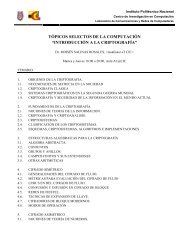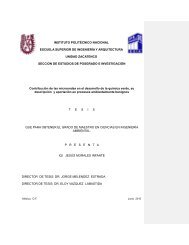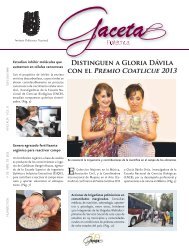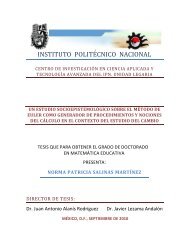Ver/Abrir - Repositorio Digital - Instituto Politécnico Nacional
Ver/Abrir - Repositorio Digital - Instituto Politécnico Nacional
Ver/Abrir - Repositorio Digital - Instituto Politécnico Nacional
Create successful ePaper yourself
Turn your PDF publications into a flip-book with our unique Google optimized e-Paper software.
ABSTRACT<br />
In recent years it has been a social tendency to look for a healthier way of life<br />
exploring natural options in health care, there is an extended bibliography that<br />
describes the benefits of the consumption of natural compounds from plant<br />
secondary metabolism. Especially, compounds from phenol family have<br />
awakened great interest in scientists. It has been found that berries are some<br />
of the richest fruits in phenols structures. Strawberry (Fragaria x ananassa) is<br />
now in day one of the most popular fruit in the world, not only for its unique is<br />
now in day but also for the benefits to human health of its consumption, due to<br />
the phenolic compounds present in this fruit, particularly flavonoids, which<br />
have shown to have antioxidant properties. Most prominent among the<br />
flavonoids are the anthocyanins, plant colorants responsible for the red color of<br />
strawberries.<br />
Strawberries are an important part of Mexico's economy, mainly because of<br />
their export market. In order to satisfy market needs, Mexican strawberry<br />
producers must pay royalties to get plants. Thus, new strawberry varieties<br />
showing to be competitive with yield of American and European varieties have<br />
been developed in México. However, anything is known about the internal<br />
quality of their fruit. The goal of this study was to evaluate the antioxidant<br />
capacity of the Mexican strawberry fruits, by measuring inhibition of the free<br />
radicals 2,2-difenil-1-picrilhidrazil (DPPH) and the 2,2'azinobis-(3-<br />
etilbenzotiazolin 6-sulfonic-acid) (ABTS) in three phenolic fraction obtained<br />
from mexican varieties CP. Zamorana and CP. Jacona, and also from foreigner<br />
strawberry verities Chiflon, Albion, Festival and Kristal. The flavonoids fraction<br />
showed higher antioxidant capacity than the other.<br />
The antioxidant capacity of Mexican strawberry varieties, make them<br />
competitive with the foreign varieties. Fruits from Jacona and Zamorana<br />
varieties had higher antioxidant activity than those from Albion and Chiflon,<br />
3
















